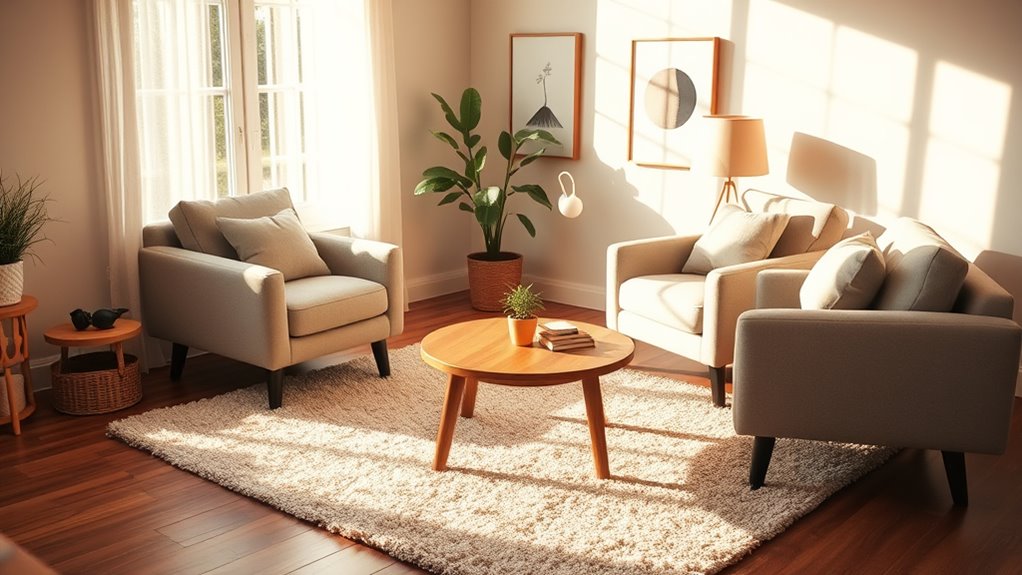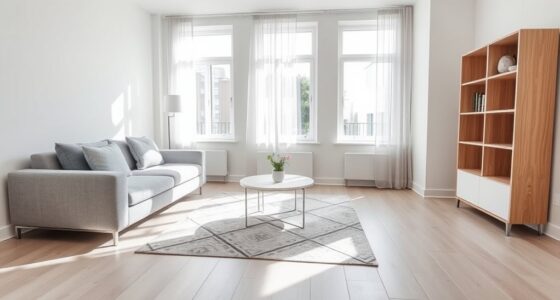To choose a rug for a small living space, measure your room carefully and select a size that leaves about 18-30 inches of clearance around furniture. Opt for light colors and neutral tones to make the space feel larger and brighter. Incorporate patterns like stripes or large-scale designs to create visual expansion. Layer smaller rugs or use visualization tools to preview your selection. Keep the placement practical—if you continue, you’ll find more tips to make your space feel open and inviting.
Key Takeaways
- Measure your space accurately and select proportionate rug sizes to avoid clutter and enhance room harmony.
- Use light colors and large-scale patterns to create an illusion of spaciousness.
- Extend the rug beyond furniture edges by at least 6-8 inches for better room definition.
- Choose durable, easy-to-maintain materials like wool or synthetic fibers for practicality.
- Visualize placement with painter’s tape or digital tools to ensure the rug complements your interior balance.
Measure Your Space Carefully Before Shopping
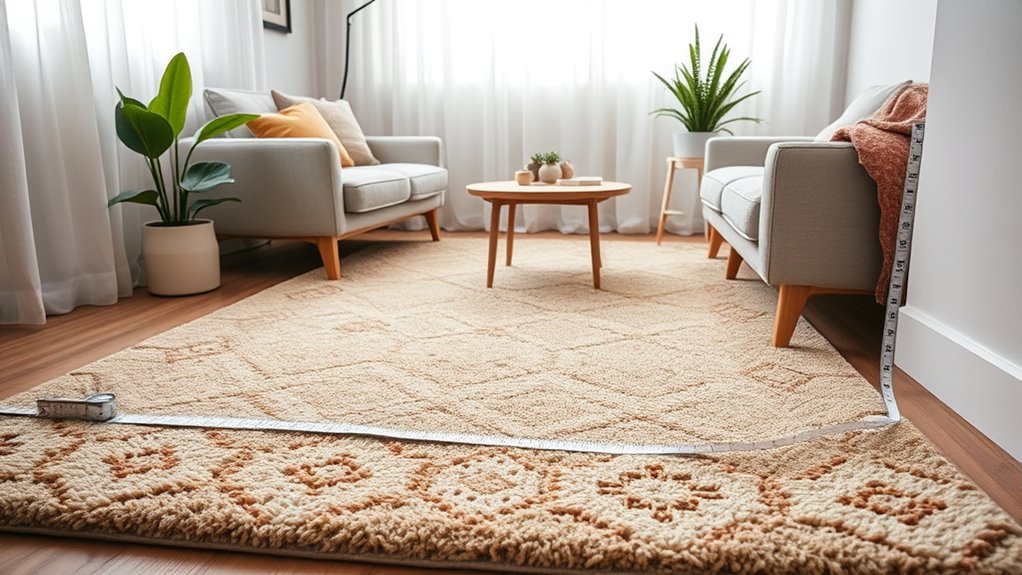
Before shopping for a rug, you need to measure your space carefully to guarantee a proper fit. Start by noting the room dimensions in feet or inches, so you understand the available area for your rug. Use painter’s tape to mark the rug boundaries on the floor, helping you visualize the rug size and how it fits within your space planning. Consider furniture placement and measure the area occupied by key pieces like sofas and chairs. Don’t forget to leave enough clearance—about 18-30 inches—around furniture for comfortable movement. Double-check your measurements against standard rug sizes, such as 6×9 or 8×10, to find the best fit. Accurate measurements ensure your rug complements your space and enhances your small living area. Paying attention to size proportions can help you select a rug that balances well with your furniture and room dimensions.
Prioritize Light Colors and Neutral Tones
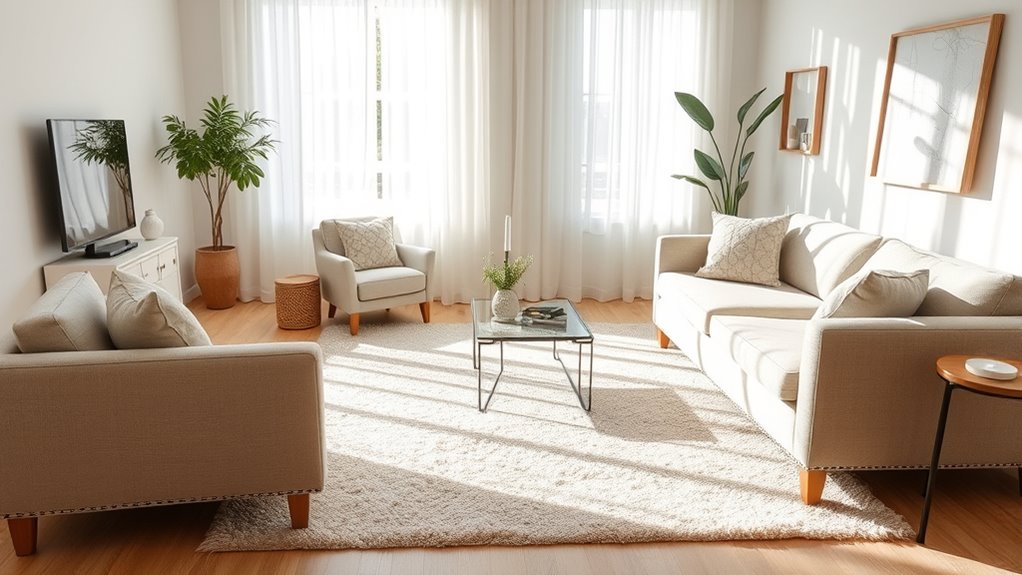
Choosing the right color palette for your rug can substantially influence how spacious your small living area feels.
Light-colored rugs in soft shades like cream, taupe, or gentle grey create an illusion of more space and openness. Neutral tones foster a calm, cohesive atmosphere that enhances the room’s sense of spaciousness without clutter.
These hues reflect natural and artificial light, brightening the space and reducing shadows. Opting for all-over patterns in subtle shades adds visual interest while maintaining an airy, uncluttered feel.
Incorporating light-colored rugs with soft textures or understated patterns prevents the room from feeling busy or cramped. Prioritizing neutral tones and light hues helps your small living space feel more open, inviting, and balanced.
Choose the Right Rug Size for Your Room
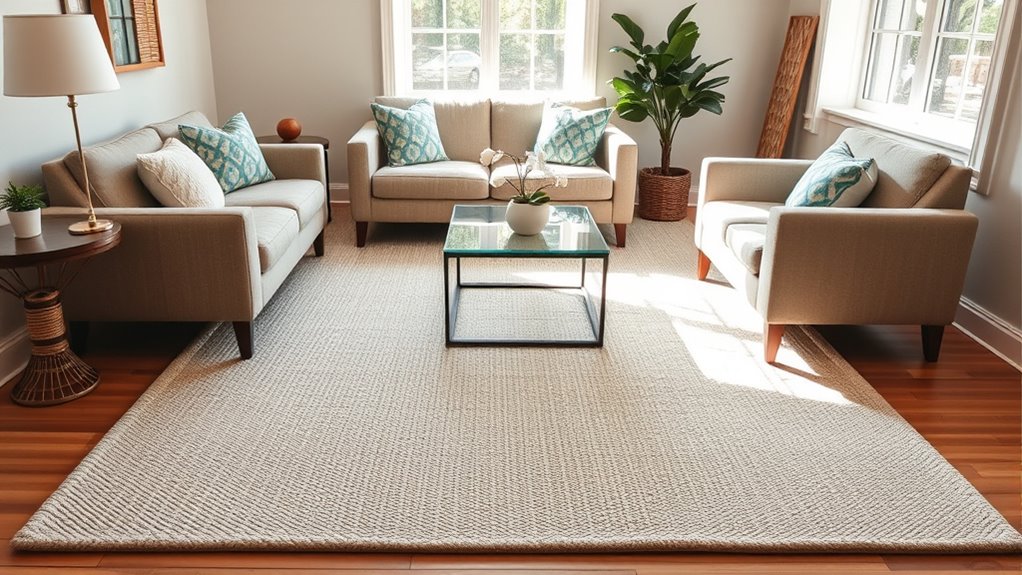
Selecting the right rug size is essential to balancing your small living space. To achieve proper coverage, measure your room dimensions carefully. Consider rugs like 6×9 feet or 8×10 feet to prevent overwhelming the space. Incorporating vertical storage solutions can help maximize the area around your rug and furniture. Use visualization techniques, such as painter’s tape on the floor, to preview how different rug sizes will fit within your room. Remember that a cohesive design can be achieved by choosing a rug that complements your overall decor style and furniture arrangement. Additionally, understanding the material and texture of your rug can influence how well it integrates with your existing furnishings and enhances the room’s comfort. When planning your furniture layout, guarantee the rug leaves 18-30 inches of clearance around pieces for comfortable movement. Considering cybersecurity when shopping online can help protect your personal information during the purchasing process. Properly selecting the right rug also involves considering rug durability, especially in high-traffic areas of your small space.
Opt for Patterns That Create Visual Expansion
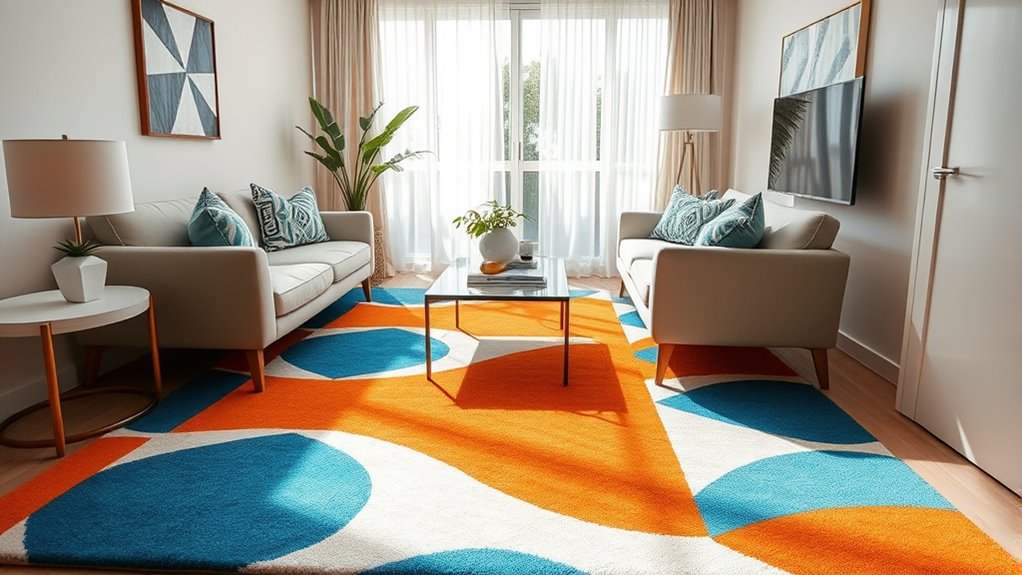
Choose rugs with large-scale, repetitive patterns or light colors to make your small space feel bigger.
Horizontal stripes or linear designs that run perpendicular to the room’s long walls can also create a sense of width.
Opting for these patterns helps guide the eye and visually expand your living area.
Use Horizontal Stripes
Horizontal striped rugs can instantly make a small living space feel wider and more open by drawing the eye outward. To maximize this visual illusion, consider the following:
- Choose striped rugs with horizontal stripes to enhance space enhancement.
- Place the rug so the stripes run parallel to the shortest wall, amplifying room illusion.
- Opt for simple, bold stripes to prevent visual clutter and create a clean, expansive feel.
- Select a rug size that fits well within your space, ensuring the stripes guide the eye across the room without overwhelming it. Additionally, selecting aesthetic wall organization solutions can complement your rug choice by reducing clutter and highlighting your decor. Understanding contrast ratio can also help you appreciate how different elements in your room contribute to overall visual harmony. When choosing a rug, consider also the material quality to ensure durability and comfort over time.
Favor Large-Scale Patterns
Large-scale patterns can considerably enhance the sense of space in a small living area by drawing the eye outward and creating visual depth. Choosing rugs with bold, repetitive designs or big geometric patterns helps make your room feel larger. These patterns create a perception of space and add visual interest without overwhelming the area. Neutral-colored rugs with simple motifs also work well, as they unify the decor and reduce clutter. All-over large-scale patterns tend to expand the room visually, making it seem less cramped. To maximize this effect, select rugs with increased size and spacing. Incorporating these patterns shifts focus from room size to design, helping your small living space feel more open and inviting. Understanding visual perception principles can further guide your choices for creating an open feel, especially when considering aesthetic balance. Paying attention to scale and proportion is essential to ensure the patterns complement rather than overpower the space. Additionally, considering color harmony can enhance the overall cohesiveness of your decor. Recognizing how design elements influence spatial perception can further improve your rug selection.
Incorporate Light Colors
In small living spaces, incorporating light colors in your rugs can make a significant difference in creating a sense of openness. Light-colored rugs in neutral shades like cream, taupe, and soft gray reflect natural light, creating an illusion of more space. Patterns such as all-over geometric designs or subtle stripes in light tones help enhance the feeling of openness and reduce clutter. Choosing rugs with minimal or no busy patterns prevents visual overload, maintaining a clean look. Consider soft gray or cool-toned options like pale blue or icy white to foster a calming, spacious atmosphere. Additionally, understanding how visual perception influences our spatial awareness can help you select the most effective rug designs. Here are four ways to evoke emotion:
- Reflect natural light to brighten the room.
- Use light tones to trick the eye into perceiving a larger space.
- Opt for neutral shades to keep the room feeling airy.
- Incorporate calming colors for a peaceful ambiance. Exploring spatial perception can further enhance your understanding of how color and pattern choices impact room size perception. Incorporating AI-driven design insights can also inspire innovative decor solutions that maximize small space potential.
Incorporate Stripes and Horizontal Designs
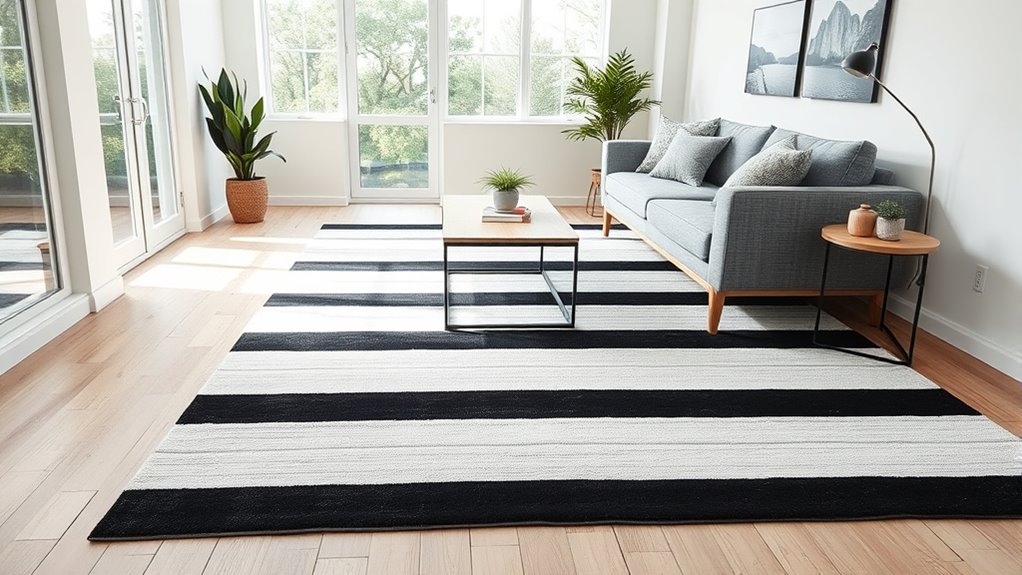
Adding striped rugs with horizontal lines can substantially enhance a small living space by creating the illusion of width. These rugs draw your eye side to side, making narrow or compact rooms feel more expansive. Opt for striped rugs with neutral or light tones to maximize openness without cluttering the decor. Placing a striped rug perpendicular to long walls emphasizes room width and balances proportions. Consistent stripe patterns and colors help keep the space cohesive while boosting the visual illusion of space expansion. Incorporating design principles like balance and proportion further enhances the room’s overall feel. Use the table below to explore how different rug designs influence your small living space:
| Rug Design | Effect | Best Placement |
|---|---|---|
| Horizontal stripes | Creates room width | Perpendicular to long walls |
| Light tones | Enhances openness | Centered in the room |
| Bold patterns | Adds visual interest | As a statement piece |
| Cohesive colors | Maintains harmony | Throughout the space |
Select Textured Rugs to Add Depth Without Clutter
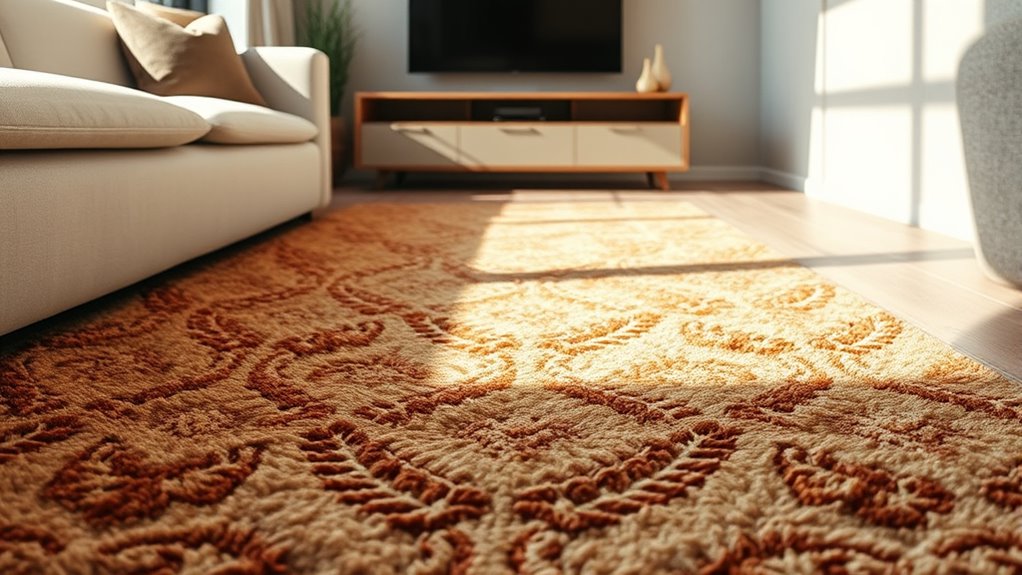
Choosing textured rugs can add valuable depth to your small living space without making it feel crowded. Light shag rugs made of plush or faux fur create visual interest and warmth. Incorporating visual aids such as swatches or digital mockups can help you better envision how different textures will work together in your space. Additionally, considering the architectural significance of the rug design can enhance the overall aesthetic and harmony of your room. As automation and innovative materials advance, selecting rug manufacturing techniques that emphasize quality and texture can further elevate your decor. While subtle patterns keep the room open and airy, by balancing different textures, you enhance dimension without sacrificing a sense of space.
Enhance Room Dimension
Have you considered how textured rugs can transform a small living space? They add visual depth without clutter, making your room feel larger and more inviting.
To enhance room dimension, focus on these key ideas:
- Use a light-colored textured rug to reflect more light, increasing the perception of space.
- Incorporate subtle textures that create a layered look, adding interest without overwhelming the room.
- Mix different textures, like plush shag with flatweave, to subtly define zones and add depth.
- Choose minimalist patterns to prevent visual busyness, keeping the space airy and spacious.
Choose Light Shag Rugs
Ever wondered how to make a small living room feel more open and inviting? Opt for light shag rugs to create an airy feel in small living spaces. Their soft plush pile adds texture and depth without cluttering the room.
Light-colored rugs, like white, cream, or pastels, enhance the room size illusion, making your space appear larger. The textured surface provides visual interest while maintaining simplicity.
Plus, these rugs reflect light, boosting brightness and openness. They’re also practical, as light shag rugs are easy to clean and maintain, perfect for everyday spills and messes.
Choosing the right textured rug helps balance comfort and style, giving your small living space a cozy, spacious vibe without overwhelming it.
Balance Texture and Space
To add depth to your small living space without creating clutter, opt for textured rugs made of faux fur or woven fibers. These materials introduce texture that enhances visual interest while maintaining a spacious feel.
Choose rugs in neutral or cool tones to keep the room open and airy. Subtle patterns or embossed textures add dimension without overwhelming the space. Layering a textured rug over a flat-woven base can further increase depth while preserving light reflection, making the room appear larger.
To evoke emotion, consider these options:
- Feel the tactile surface that invites touch and warmth.
- Capture light and shadow for a dynamic, lively atmosphere.
- Use layering to create visual interest without clutter.
- Select neutral tones to keep your space feeling open and fresh.
Focus on Durable, Easy-to-Maintain Materials

When choosing a rug for a small living space, selecting durable, easy-to-maintain materials is essential to guarantee long-lasting style and functionality. Opt for durable materials like wool, nylon, and polypropylene, which resist wear and tear.
Wool rugs naturally resist stains, trap allergens, and wick moisture, making them easy to maintain over time. Synthetic fibers such as polypropylene and polyester are cost-effective, stain-resistant, and simple to clean with regular vacuuming and spot cleaning.
Natural woven fibers like jute, sisal, and seagrass are sturdy, eco-friendly options that withstand high foot traffic and require minimal upkeep. Additionally, choosing low-pile or flatweave rugs helps prevent dirt from trapping, simplifying cleaning and ongoing maintenance in small spaces.
Layer Smaller Rugs for a Cohesive Look
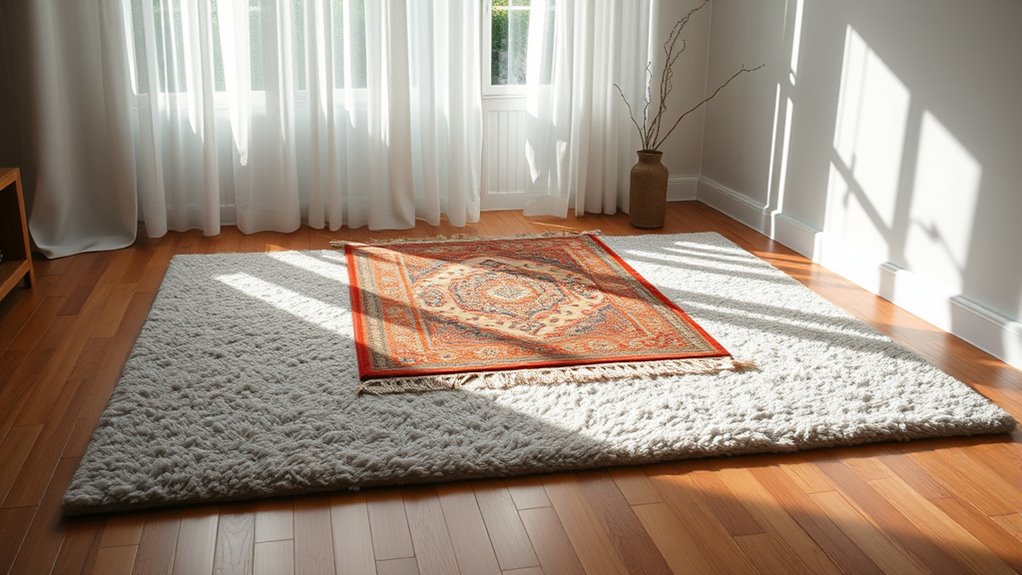
Layering smaller rugs over larger ones adds visual interest and helps define different areas in your small living space.
Mix textures and patterns to create depth and make the room feel more dynamic. Just be sure the smaller rugs are proportionate and placed strategically to keep your space balanced and inviting.
Mix Textures and Patterns
Adding smaller rugs over a larger base rug can instantly enhance the depth and visual interest of a small living space. To achieve this, focus on *texture mixing* by layering rugs with different tactile qualities, like a shag rug with a flatweave.
Thoughtfully coordinate patterns by pairing solid or subtle designs with more intricate ones, maintaining *pattern coordination* without clutter. Use *complementary colors* to unify the layered rugs, ensuring they create harmony rather than chaos.
Lastly, strategically position the smaller rugs to define zones, boosting both *visual interest* and *design cohesion*. Remember, layering rugs in this way adds dimension, making your small living space feel more dynamic and inviting without overwhelming it.
Use Varying Sizes
Using rugs of varying sizes is an effective way to create a cohesive and inviting small living space. Layered rugs add visual depth, making your room appear larger and more dynamic.
When choosing rug sizes, aim for smaller rugs that are proportionate—about 2-4 feet smaller than the main rug—to *guarantee* balanced layering. Place these layered rugs strategically, such as under coffee tables or in seating zones, to define spaces without cluttering the small space.
Use rugs with complementary colors or patterns to unify the decor and enhance the overall cohesive look. Layering different rug sizes allows you to experiment with textures and styles, offering versatility in decor while maximizing the perception of space and creating a well-proportioned, inviting atmosphere.
Enhance Room Depth
To enhance the sense of depth in your small living space, place smaller rugs over a larger base rug to create visual layers that define different zones. Layered rugs add dimension, making your room feel larger and more inviting.
Use proportionate rugs, typically 1-2 feet smaller on each side, to maintain balance and avoid clutter. Position these rugs strategically, like under a coffee table or seating area, to highlight distinct zones and enhance room depth.
To amplify the effect:
- Choose contrasting textures or patterns for layered rugs to add visual interest.
- Keep colors light and patterns simple to boost openness.
- Ensure layered rugs coordinate without overwhelming.
- Focus on proportionate sizes to create harmony and define zones seamlessly.
Use Visualization Tools to Preview Your Rug
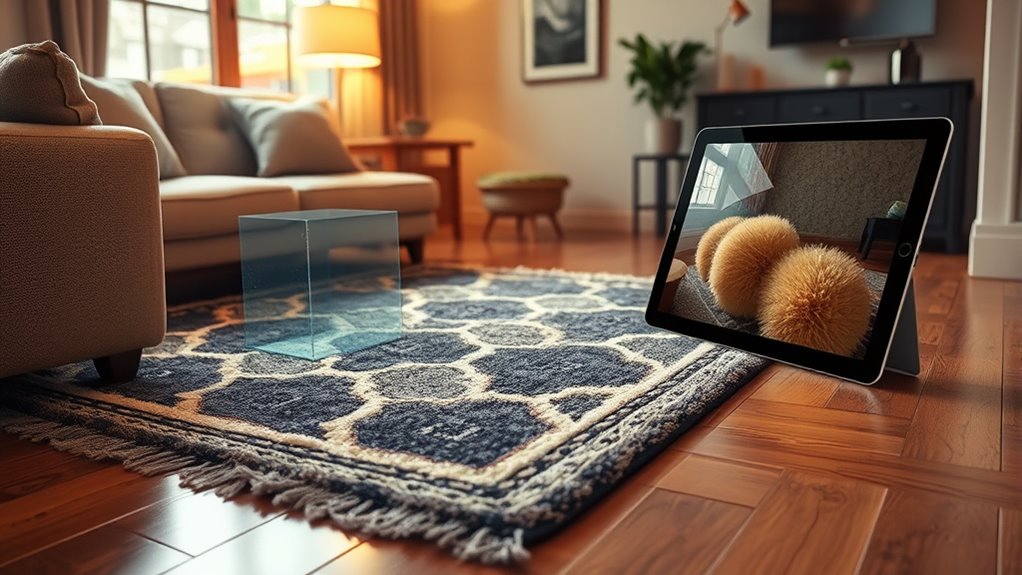
Visualization tools like online room planners and augmented reality apps make it easy to see how different rugs will look in your small living space before you buy. These digital previews let you preview your rug by uploading photos or using templates that match your room dimensions. They help you experiment with rug size, patterns, and textures, ensuring your choice complements your interior design. Using these tools prevents sizing mistakes by showing how the scale of the rug relates to your furniture and room layout. Here’s an example of how visualization tools can assist:
| Tool Type | Feature | Benefit |
|---|---|---|
| Room planner | Upload photo or use templates | Accurate digital preview |
| Augmented reality | See rug in your space via camera | Realistic visualization |
| Pattern & color preview | Experiment with colors and textures | Find perfect match |
| Scale adjustment | Resize rug within the app | Avoid sizing errors |
| Interior design aid | Combine multiple elements for cohesive look | Streamlined decision-making |
Consider Practical Placement to Maximize Space
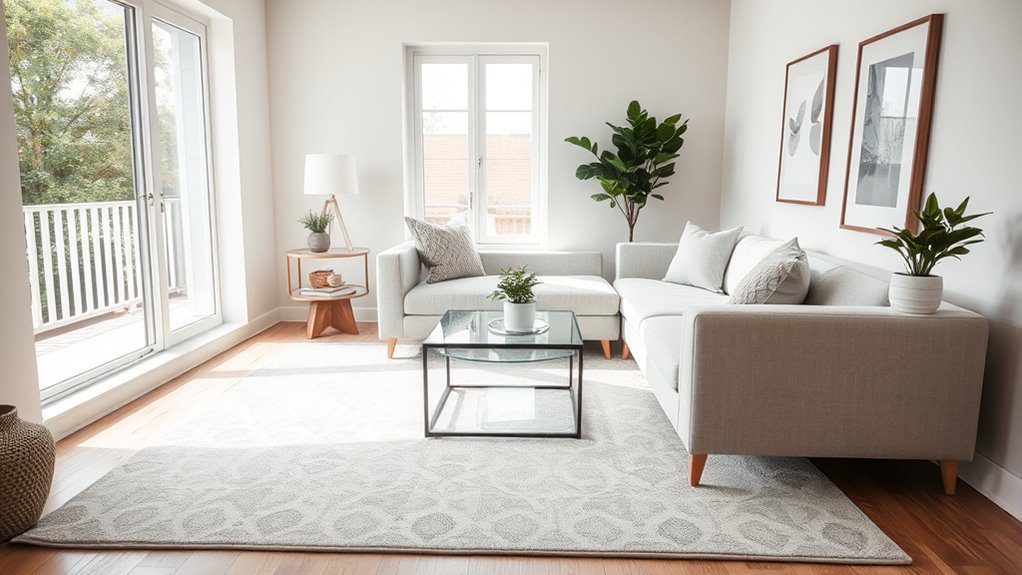
When placing your rug in a small living space, practical positioning can make a big difference in maximizing comfort and style. Proper rug placement can define your area without overwhelming the room size.
To achieve space maximization, keep these tips in mind:
- Extend your rug at least 6-8 inches beyond furniture edges to frame the space beautifully.
- Leave 18-24 inches of walking clearance around furniture for easy movement.
- Place the front legs of sofas and chairs on the rug to anchor seating and create cohesion.
- Use layered small rugs over a larger one to visually expand the area and define zones.
Always measure your room and furniture beforehand to select the right size, ensuring your area rugs enhance functionality and balance within your small space.
Frequently Asked Questions
What Shape Rug Is Best for a Small Living Room?
For a small living room, the best rug shape depends on your space and style. Rectangular rugs are versatile and traditional, offering balance.
If you want a cozy feel, go for a round rug to soften the room.
Square rugs work well if your furniture is symmetrical, while oval shapes add a flowing look to tight corners.
Choose a shape that complements your layout and enhances your room’s visual harmony.
What Kind of Rug Is Best for a Small Room?
Like the opening scene of a well-crafted play, choosing the right rug sets the tone for your small room. You should opt for light-colored, neutral tones like cream or taupe to open up the space.
Rugs with horizontal stripes or subtle large-scale patterns add width and interest without overwhelming. Make sure it’s large enough to extend beyond your furniture, creating a cohesive, inviting environment that feels both cozy and expansive.
What Is the Rule on Rugs in a Living Room?
The rule for rugs in a living room is to choose one that balances the space and furniture. You should guarantee the rug is at least 6-8 inches wider than your sofa on each side, creating a cohesive look.
Aim for an 8’x10’ or 9’x12’ rug to anchor the seating area.
Keep furniture either fully on or off the rug, and leave enough walkway space to maintain flow.
How Do You Size a Rug for a Small Living Room?
They say, “Measure twice, cut once,” and that’s true when sizing a rug. To get it right, measure your seating area and add 8-10 inches on each side.
Use painter’s tape to visualize the size on your floor and confirm the rug extends under your furniture’s front legs.
Leave 18-24 inches of bare floor around the rug to keep your small space feeling open and inviting.
Conclusion
By carefully selecting a light-colored, appropriately sized rug with patterns that create visual space, you can make your small living area feel more open. For instance, Sarah’s choice of a striped, neutral-toned rug instantly made her apartment appear larger and more inviting. Remember, using visualization tools and considering placement help you find the perfect fit. With these tips, you’ll transform your small space into a stylish, comfortable retreat effortlessly.
